About the Kitchen
What did the kitchen sound like?
The kitchen was a noisy, lively place. In a tavern as big as this one, there would have been a cook who was in charge, and several other people working for her. The cook might be the tavern keeper’s wife, and she may have her young children in the kitchen too. There would be lots of talking: the cook giving orders, the servants gossiping and complaining, the children laughing and fighting. The fire would be crackling, the pots clanking, and dishes rattling. People would continually be coming in and out with firewood or supplies. Dogs would be barking. There would be the sound of people using kitchen tools to chop vegetables and grind spices. It was a place of constant noise and activity from very early morning until the end of the day.
A New England Kitchen. Courtesy of the Avery-Copp House Museum, Groton, CT.
A Closer Look at the Painting
By looking at the activity going on outside the tavern, what are some of the sounds that you think would be heard by the people working in the kitchen? Would they hear people arriving? What would that sound like? Would they hear people working? What about animal sounds?
What did the kitchen smell like?
The most constant smell, always drifting on the air outside and filling the inside of the kitchen, was the smell of the wood burning in the fireplace. Even when the fire was out, the room would retain this smoky, woodsy smell. And it was not just the room that would smell smoky; the smell of the fireplace gets onto the clothes and in the hair of everyone who works around it, so people working in the kitchen would always smell a bit like a camp fire.
There were lots of cooking smells too, depending on the season of the year and what the cook decided to have on the menu. There might be meat roasting, or a big pot of stew bubbling over the fire. Once or twice a week there would be bread baking in the oven, and almost every day there would be a pie of some kind cooling on the windowsill. Bunches of dried herbs hanging from the ceiling bring the smell of the garden indoors, and the grinding of spices might fill the air with the smell of ginger, cinnamon, and pepper. If the kitchen was very hot or smoky, the doors might be open, allowing fresh air and farmyard smells to come inside. Some of these smells were pleasant, such as freshly mown hay in the summertime. Others were not so nice, such as cow manure or the pig sty.
A Closer Look at the Painting
What are some of the smells that might drift into the kitchen from outside? Can you imagine some smells from the kitchen that visitors arriving at the tavern might notice?
What role did animals play at the inn?
Mice and rats could be a problem in the kitchen because they are attracted to the wide variety of food found there. They are nocturnal, so are active at night when no-one is around. Many varieties of mousetraps and herbal repellants existed, but the best protection was to have a cat or two. These cats had to work for a living; in exchange for a warm bed near the fire and an occasional bowl of cream, they were expected to keep the kitchen free of pests.
Insects were another problem in the kitchen because there were no screens on the window and doors. Mosquitos do not like the smell of smoke, so they were not too troublesome in the kitchen, but flies were a constant challenge. People did not know that flies carry bacteria, but they knew that flies were bothersome! Moths like to lay their eggs in grain; herbs such as wormwood were used to repel them. Ants like sweet things; precious sugar had to be kept in a tightly closed container. This was also true for molasses and honey. Many birds like to eat insects, so bird houses would be put up near the building to attract them, with the hope that the birds would help to keep the insect population under control.
Racoon eating eggs. Courtesy of the Avery-Copp House Museum, Groton, CT.
Many wild animals were attracted to farmyards; they would try to get into the henhouse or the barn in order to eat eggs, or even to catch the chickens, ducks, and geese. Dogs sleeping in the barn would guard the farm animals from predators such as foxes and raccoons.
A Closer Look at the Painting
What evidence can you see of animals at work in this painting? Are there any animals here that are not expected to work in some way, even if they are resting now? Can you find a bird house?
How was the fireplace, or hearth, the heart of the inn?
The fireplace was the center of life in the kitchen. It was the only source of warmth during cold weather, and was also the source of all heat for cooking food. In addition to providing heat for comfort and cooking, this was also where water was heated to wash dishes, do laundry, and to provide warm water for washing faces and hands and for taking the occasional bath.
The fire was lit first thing in the morning, using coals from the previous night that had been kept warm by piling them up against the fireplace wall and covering them with ashes. This is called “banking the fire”. The morning fire would be important for making breakfast, heating water for tea and coffee, and washing dishes afterwards. This pattern would continue throughout the day for every meal. With all the activity in a busy, crowded kitchen, the fireplace could be a dangerous area. Metal pots and pans were arranged in front of the fire, or hung over the flames on metal hooks; all these things get very hot, and often have hot liquids in them that can be spilled. Sparks can fly out of the fireplace. Children can fall in. The cook had to be very alert to all these dangers. She also had to make sure not to run out of firewood. Often one of the children would have the job of bringing
So how much firewood did the fireplace use?
It has been estimated that a medium sized household, heating and cooking with wood, would use 30 to 40 cords of wood each year. A cord is a measurement of a pile of wood that is 4 feet wide, four feet high, and eight feet long. This amount of firewood used by a family would be equal to a stack 4 feet wide, 4 feet high, and 300 feet long – about as long as a soccer field. A tavern would use even more wood, because of having a fire burning in the front tavern room, heating all the bed chambers, and having extra laundry and dishes to wash.
Men and boys had the job of cutting down trees, then chopping and stacking firewood. Wood had to be stored in a shed to keep it dry, and brought in to all the fireplaces as it was needed. Boys used an axe to chop larger logs into small pieces of kindling, which were needed when starting a fire. Children also gathered sticks from the woods to use for kindling. Providing firewood for this tavern would have been a constant chore.
Wood pile.Courtesy of the Avery-Copp House Museum, Groton, CT.
A Closer Look at the Painting
What clues can you see in the painting that relate to the fireplace? Do you see any evidence of the work that is done to produce firewood? Where was the wood stored? What tools do you think were used to cut up firewood?
What kinds of tools did a busy kitchen need?
Cooking equipment that was used around the fire was made of cast iron, brass, or tin. A busy tavern kitchen might have several frying pans with legs, called spider pans. There would be large pots with handles that could hang over the fire to make soup or stew. Iron pots with lids, called “Dutch Ovens”, were set on a pile of hot coals on the hearthstone; they were used to bake pies, gingerbread, and other treats. A tin reflector oven could be placed in front of the fire to roast meat.
Pottery. Courtesy of the Avery-Copp House Museum, Groton, CT.
The kitchen would be full of storage containers to keep food from being spoiled or eaten by mice. These containers might be large pottery crocks, full of pickles, eggs, or molasses. Smaller containers made of tin or wood could be used to hold spices, coffee, and tea. Large barrels in the cellar or the pantry were used to store corn meal and flour, while the coolest room in the house would hold dairy products such as butter and cheese.
A Closer Look at the Painting
What do you think would be stored in the pottery crocks? What would you make in the mixing bowls? What could you grind up in the mortar and pestle?
What was on the menu?
Whatever the cook decided to make that day. Visitors to the tavern could not order from a menu unless it was a very large and fancy tavern. The cook would decide what to make depending on the season of the year and what she was able to buy from local farmers or fishermen. Taverns near the sea would have fresh fish available, while those located near inland farming communities might have plenty of ham or bacon instead. In the summer there would be an abundance of fresh fruits and vegetables, but in the winter the cook would rely heavily on preserved food that was smoked, dried, or pickled.
Tavern visitors did not expect a wide choice, and, especially in rural areas, they did not expect very high quality. If the food was edible, that was enough. Travelers were pleasantly surprised if they happened to visit a tavern with delicious food, and sometimes made notes about the experience in their diaries. In the city, where there was more competition for customers, taverns would compete with each other to offer the best food or the best ale.
Courtesy of the Avery-Copp House Museum, Groton, CT.
A TAVERN RECIPE TO TRY
Pounded Cheese
Ingredients
2 cups of shredded cheese, any variety. It is nice to mix colors, or have some mild cheese mixed with some sharp flavors.
¼ cup butter, more or less. This is to soften the cheese.
1 or 2 tablespoons mustard, according to taste. This is prepared mustard, not mustard powder.
1 or two tablespoons apple cider. A little more may be needed if the cheese is very dry.
1 teaspoon curry powder
a dash of cayenne pepper powder
Directions
Mix cheese, butter, mustard, and cider in a mortar with a pestle, or pound in a wooden bowl until the mixture is smooth. Add more butter if it is too thick. Once the mixture is soft, sprinkle the spices on top and mix them in. Adjust spices to your taste.
Serve on crackers or bread. It is delicious melted.
https://player.vimeo.com/video/232834828


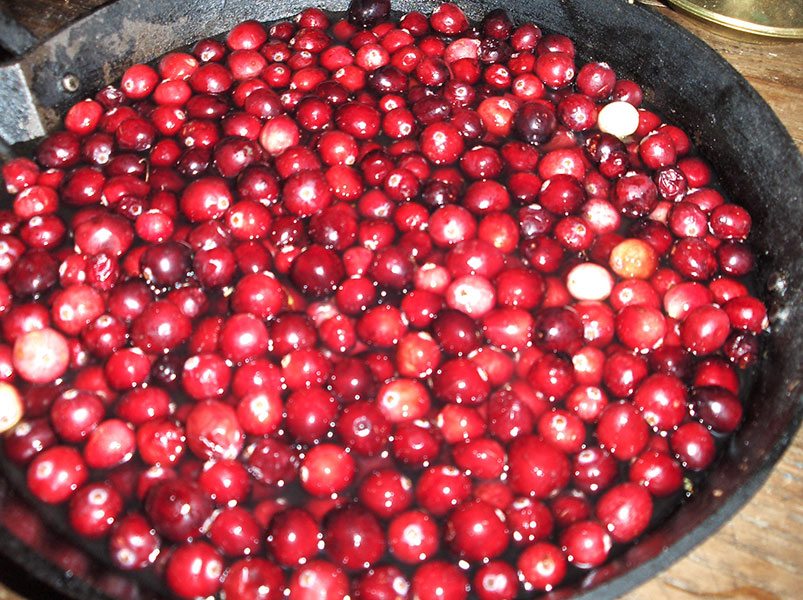
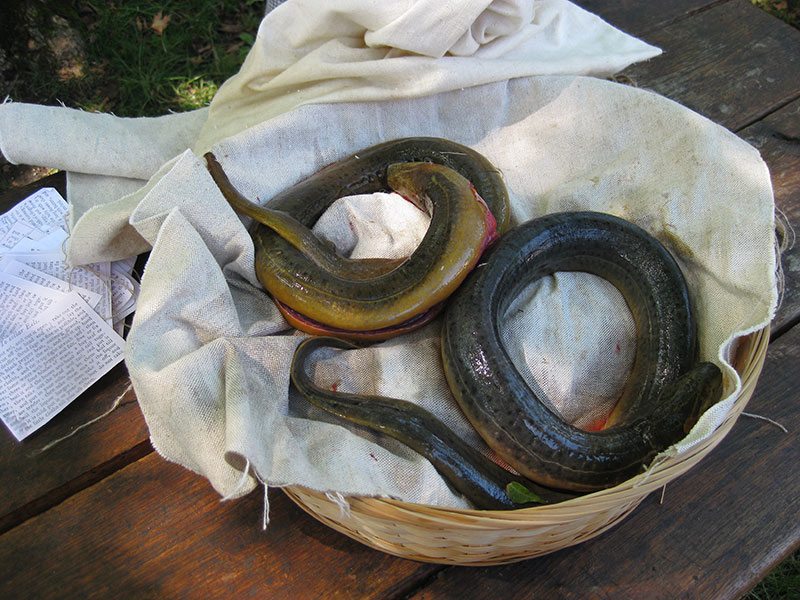
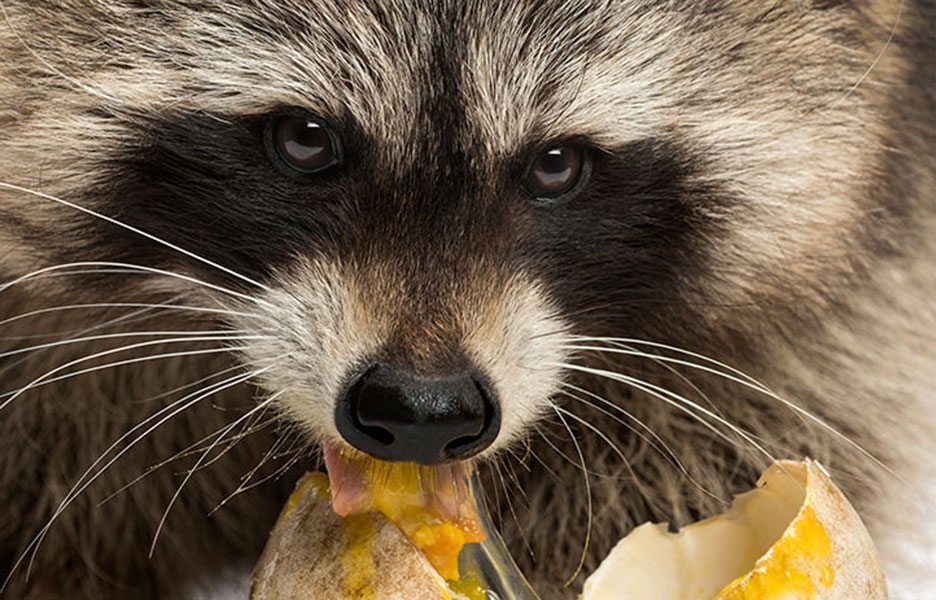

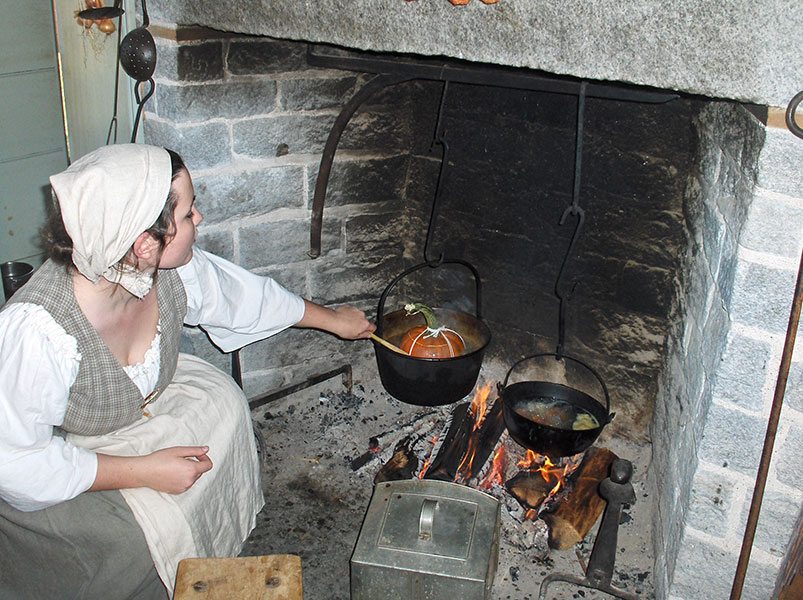

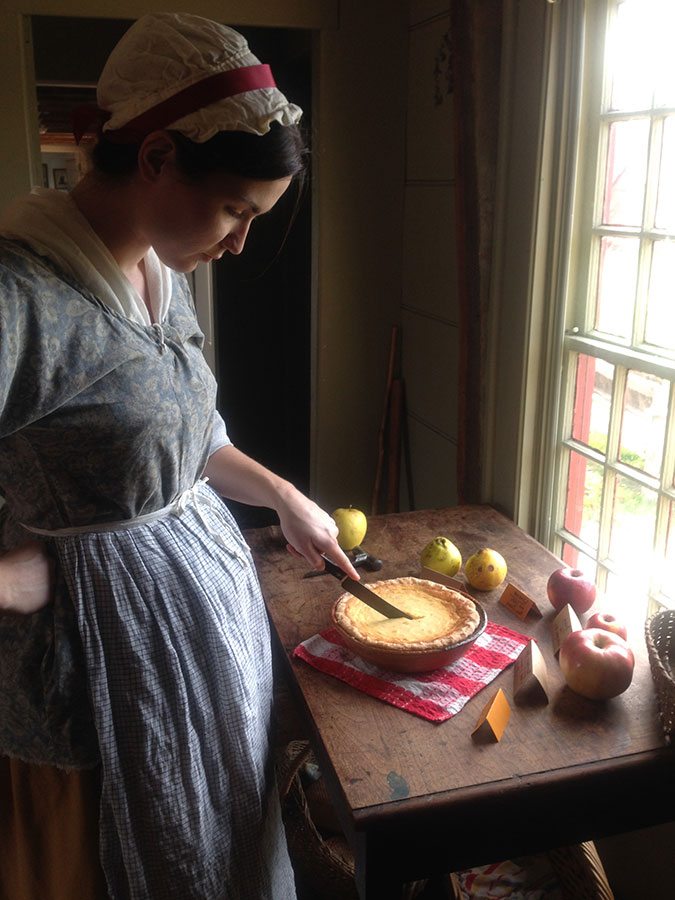
Have a question or comment regarding SEE/change? Enter your email and comment here.
"*" indicates required fields